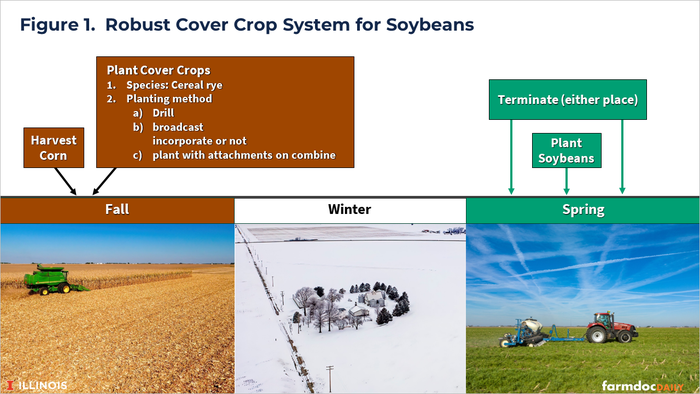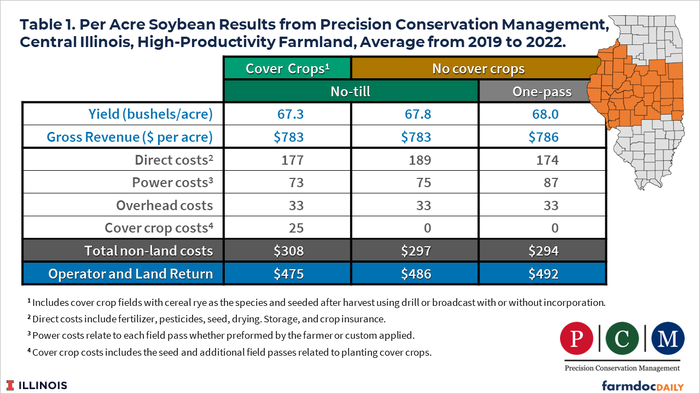January 30, 2024

By Gary Schnitkey and Laura Gentry, University of Illinois
Cover crop use in soybean fields is evolving to a standard system. This system plants cereal rye after harvest in the fall and plants soybeans early in the spring. This system typically yields the same as systems without cover crops and has reduced herbicide costs. Despite these advances, this cover crop system requires revenue from cost-share or carbon programs to have the same returns as systems without cover crops. We describe the economics of this system using results from Precision Conservation Management (PCM).
Precision conservation management
We summarize data from Precision Conservation Management (PCM), a farmer service program led by the IL Corn Growers Association and Illinois Soybean Association, in partnership with over 30 entities, including other commodity associations, conservation groups, private foundations, supply chain providers, the Soil and Water Conservation Districts, and the Natural Resources Conservation Service (NRCS).
PCM was started in 2015 to address the goals of the Illinois Nutrient Loss Reduction Strategy. The mission of PCM is to help farmers make decisions about adopting on-farm conservation practices in a financially responsible way. Through PCM’s regional specialists, PCM works one-on-one with over 500 farmers in Illinois, Kentucky, and Nebraska (see PCM website).
This article evaluates a subset of PCM fields to understand the economics of cover crops in soybeans more fully. The most profitable farms using cover crops were identified, and characteristics of the most profitable fields were evaluated. Interviews were conducted with a small subset of farmers with the most profitable fields.
Description of system
Integrating cover crops on Illinois fields presents challenges as cover crops typically involve significant system changes. The following system emerges as a standard for soybeans as the next crop (see Figure 1):

Species
Cereal rye is the species of choice when soybean is the following crop. Cereal rye typically has lower costs than other species and can be planted relatively late in the fall and still emerge in the spring. Cereal rye overwinters reliably most years across Illinois, taking up nitrogen in the fall and spring and releasing it back to the crop later in the growing season. Termination can be accomplished relatively easily with a broad-spectrum herbicide such as glyphosate.
Planting
Planting typically occurs after corn harvest, although some farmers also plant at harvest with attachments to the combine. Planting before harvest has fallen out of favor because seeding methods, such as aerial applications, are relativity expensive. Planting can occur by:
Drill — Some farmers drill, which results in good emergence. A significant disadvantage of drilling is that it is slow. Drilling may work on one or two fields, but drilling becomes problematic if large acreages are devoted to cover crops.
Broadcast without Incorporation — Cereal rye can be applied with fall fertilizer applications. This method avoids an additional field pass, with the only additional cost being the cost of the seed. Emergence can be an issue.
Broadcast with incorporation — After broadcast application, fields are worked lightly with vertical tillage-type implements.
Seeding with attachments on combine — This system eliminates the need for another field pass. The disadvantage is that it slows harvest.
Planting soybeans
Yield advantages exist for planting soybeans early, with or without cover crops. If possible, soybean planting occurs in April in central Illinois.
Terminating Cereal Rye
Farmers have different preferences for terminating cover crops. Some terminate cover crops before planting soybeans. So doing reduces the risk of having cover crops compete with soybeans for moisture in dry years.
Some wait to terminate cover crops after planting soybeans. So doing provides more material on the surface which can be moisture conserving in dry years, and potentially allows for fewer herbicide passes thereby reducing herbicide costs. Choice varies, with one farmer suggesting, “You have to do what the weather tells you to do.”
The above system is easier to adapt by those farmers already using a no-till system between corn and soybeans. For farmers using no-till, broadcasting cereal rye seeds after harvest is a straightforward step to begin cover crops. Farmers with tillage passes will find the above system more of a modification, particularly those that have spring tillage as part of their systems.
Historic results
We evaluated the results of the cover crop systems described above by analyzing PCM data. Results come from highly productive soils in central Illinois, where corn is the preceding crop. The three systems are:
Cover crops. To be included, a field must 1) use cereal rye as the cover crop species (no blends) and 2) plant cover crops after harvest using a drill or broadcast method. We did divide returns by seeding method. Drill and broadcast with incorporation had higher cover crop planting cost than does broadcast without incorporation. Higher costs was offset by a slightly higher, but not statistically different, yields.
No-till without cover crops. These systems did not have tillage passes between corn harvest and soybean planting.
One-pass without cover crops. These systems had one tillage pass between corn harvest and soybean planting. This tillage typically occurs in the spring before planting.
Table 1 shows per-acre results for the systems for the years 2019 through 2022. Results are:

Yields across the systems are 67.3 bushels per acre for cover crop systems, 67.8 bushels per acre for no-till without cover crops, and 68.0 bushels per acre for one pass without cover crops. There is no significant difference in yields across these systems. Overall, the use of cover crops does not result in lower yields, and there is evidence that cover crops reduce low-end yields (see farmdoc daily, October 3, 2023).Direct costs are $177 per acre for cover crops and $189 for no-till systems. Cover crop systems have lower direct costs than no-till systems. Most of these lower costs come from herbicides, with some farmers eliminating one herbicide pass.
Power costs are $73 per acre for cover crops and $75 per acre for no-till systems, essentially the same. One-pass systems have higher costs at $87 per acre because of the additional field pass.
Cover crop costs are $25 per acre for cover crop systems. This includes seed, and additional field passes to plant the seed.
The above historical results do not include cost share or carbon program payments. For example, several farmers using cover crops received payments from NRCS programs such as Environmental Quality Incentives Program (EQIP), Conservation Stewardship Program (CSP), or Regional Conservation Partnership Program (RCPP). Without cost share or carbon payments, operator and land returns for cover crop systems were lower than the non-cover crop systems: $475 per acre for cover crop versus $486 for no-till and $492 per acre for one-pass systems. At the current point in time, cover crop planting costs are not offset by lowering other costs or increasing yields.
Commentary
The use of cover crops in modern Midwest corn-soybeans systems is in its infancy. However, strides are being made to make cover crops an economical part of agriculture. Cover crops could be like conservation tillage in the 1970s and 1980s, a new system that takes time for farmers to improve techniques while technologies develop.
The system presented here is not unique, as other studies by the Illinois Nutrient Research and Education Council, Natural Resources Conservation Service, and University of Illinois point towards this approach. The confluence of studies pointing to the same system suggests robustness in the system.
Cover crop systems have not achieved economic parity with non-cover crop systems without additional revenue from cost-share or carbon programs. Further advances could cause cover crop systems to achieve parity. For example, cover crop systems could improve soils such that yields increase in the future.
Those yield increases could be off in the distance on the high-quality soils in central Illinois. Moreover, soil health likely plays a higher role in adverse years, such as the drought years in 1988 and 2012. When another such adverse year occurs, cover crop systems will likely show lower yield losses than on fields without cover crops.
Many of the interviewed farmers used cover crops for over five years. Most indicated that cover crops were part of the “long game” in which they were seeking the conservation and improvement of soils. Some viewed fertilizer and practice regulations as part of the future and thought that cover crop use would better prepare their operations to meet these challenges. All indicated that there is a learning curve to using cover crops.
All this information and more is featured in a new publication coming out in the March edition of Prairie Farmer titled, “Managing Risks with Cover Crops.” Be sure to check it out for more U of IL Extension analysis of cover crops as well as insights from the most profitable PCM farmers about their experiences and lessons learned using cover crops profitably. The guidebook will also be available digitally at www.precisionconservation.org.
Source: University of Illinois
You May Also Like




